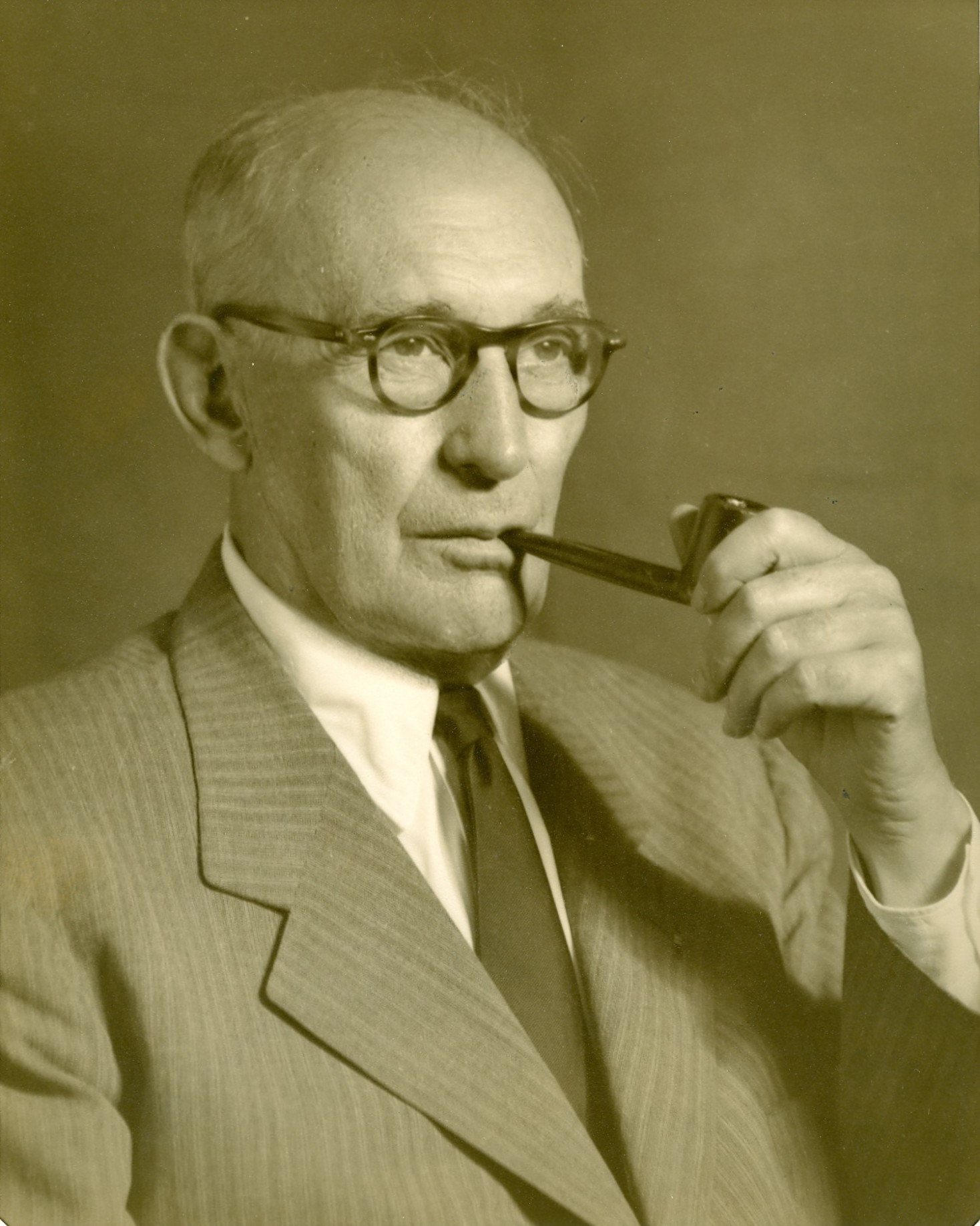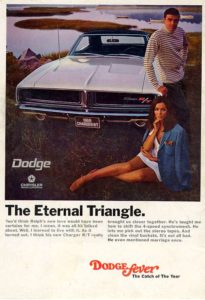This chapter surveys some of the agencies, their philosophies and approaches, and their tactics and use of imagery. It also surveys the history of public relations as a response to muckraking and as a way to speak for corporations in the marketplace of ideas.
Aside from personal ads and classifieds, mass advertising did not take off until the penny press era of the early to mid-1800s, when high-circulation newspapers allowed widespread access to consumers. By the 1920s print advertising reached a new peak, exemplified by the ad above for the Jordan car. The auto company is long gone, but the advertisement was so good that it has lived on as one of the best examples of copy writing in the business.
Not every ad is great, of course. Consider this blatantly sexist ad for Dodge cars from 1969 (to the right). That same year, Marshall McLuhan said that advertising was “by far the best part of any magazine or newspaper,” since “more pains and thought, more wit and art go into the making of an ad than into any prose feature of press or magazine.” You wouldn’t know it from the Dodge ad.
Discussion questions
- Philosophy of Advertising: How did Horace Greeley’s philosophy of advertising influence advertising agencies in the late 1800s and early 1900s?
- Countering muckrakers: How successful were large corporations in countering the influence of muckrakers in the early 1900s?
- PR ethics: According to James Grunig, one of the main functions of an ethical public relations practitioner is to ensure a two-way symmetrical flow of communication. In other words, corporate opinion may be broadcast to the world, but public opinion must be understood inside the board rooms of corporations. Can you think of instances where a corporation that listened to opinion weathered a storm of criticism, and instances where one that didn’t listen ended up losing shareholder value?
- Lousy copy writer: Why did David Ogilvy say he was a lousy copy writer? What was he good at? Why?
- How easy should it be to use Google Ads for social engineering? (As described in this July 7, 2019 New York Times op-ed).
- Mad Men and Marshall McLuhan – What does the author mean when he says that “stuff” changes, and thats the biggest change of all? Esquire May 5, 2015
People & Events
Volney Palmer, George Reynell, J. Walter Thompson, N.W. Ayer, Thomas Lipton, P.T. Barnum, Ivy Lee, Edward Bernays, George Creel, Maurice and Charles Saatchi, Lee Clow, Helen Lansdowne Resor, David Ogilvy, Rosser Reeves, Leo Burnett, James Grunig
Interesting links
Advertising collections, museums and menageries
- Super Bowl ads and their ratings.
- Advertising Age — Ad history timeline – interesting, some omissions.
- Duke University: Emergence of Advertising in America also Ad Access project
- Library of Congress: The Emergence of Advertising and specific browse pages.
- Harpers Weekly advertising history
- PT Barnum’s American museum (Flash)
- Helen Landsdowne Resor — an early success in the advertising business.
- Edward L. Bernays — “scientific” public relations – Great web site explaining Bernays campaigns.
- Vintage magazine advertising – Searchable by category (fuel, shoes, home, laundry etc)
- History of Advertising Trust (British)
- A signal moment in advertising history – Kevin Horrigan of the St. Louis Post Dispatch, June 10, 2012. — “In 1922, Gerard Lambert was in his office at the family’s pharmaceutical company in St. Louis. One of his employees read him an article in a British medical journal that used the word halitosis to describe bad breath. Lambert’s father had helped invent a product called Listerine …
- Early radio commercials
- Broadcasting and advertising (Duke University library)
- How an African-American ad man changed the face of advertising. NPR Morning edition, June 15, 2015.
- Arthur W. Page,
 AT&T vice president for public relations from 1927-1947, was known for his early advocacy of corporate responsibility and what is known today as the two-way symmetrical model of PR, which he described in a 1929 article, The Problem of Forecasting Public Opinion in the US.
AT&T vice president for public relations from 1927-1947, was known for his early advocacy of corporate responsibility and what is known today as the two-way symmetrical model of PR, which he described in a 1929 article, The Problem of Forecasting Public Opinion in the US. - Museum of Public Relations – Article on Edward Bernays
Advertising history: Patent medicine and other controversies
- Mark Twain’s 1905 letter to the manufacturers of the Elixer of Life. The person who wrote the advertisements is without doubt the most ignorant person now alive on the planet; also without doubt he is an idiot, an idiot of the 33rd degree, and scion of an ancestral procession of idiots stretching back to the Missing Link.
- Jordan car (“Somewhere west of Laramie there’s a broncho-busting, steer-roping girl who knows what Im talking about…” )
- ) Lux soap, 1916, compared to the same company in 1920 (note the difference in orientation to consumer)
- Los Angeles billboard v newspaper war, 1917 (LA Times, April 2013).
- Betty Crocker reflects changes in women’s images over time
- Coca cola
- Coke and Santa Claus
- TV ads: tobacco: the Flintstones for Winston cigarettes — And another Lucky Strike (1948) – and Doctors smoke Camels
- TV ada: politics –I like Ike – Eisenhower campaign Ads Daisey Ad, Vietnam film
- TV ad — Ridley Scott talks about the Apple Mac 1984 ad. And more here: Apple Mac “1984” ad history.
Current issues in advertising and public relations
- Big tobacco targets minority youth in California. April 23, 2012.
- Adbusters — Turning advertising upside down.
- The Yes Men — Public relations on behalf of the victim.
- Corporate public relations is polluting the American psyche says Tracy Turner in this OpEd piece from May, 2012.
- Lite beer ads ruined everything says Kevin Horrigan.
- Branded content silos at Forbes will (supposedly) “shake up 100 years of journalism.” ( Worth a read, but Herb Schmertz was no visionary media hero. )
- Advertising sales has become a form of extortion in India, says the New York Times (Nov. 29, 2012)
- The new look of public relations, New York Times, April 29, 2013
- Five books on advertising that withstand the test of time, including a history of advertising that changed advertising. Adweek. May 13, 2014.
- Energy and health firms use others to spread propaganda, Center for Public Integrity, April 13, 2015.
- Dominion energy company will fight ‘misinformation’ through social media. SNL, June 26, 2015. Also see environmental group, “We are Cove Point,” for reaction.
- The 2016 Donald Trump campaign is a triumph of image over substance, according to Neal Gabler, writing in Bill Moyers & Co. March 4, 2016.
- Social media vs bad press — Nieman reports, 2009. And more about social media tactics, 2011.

